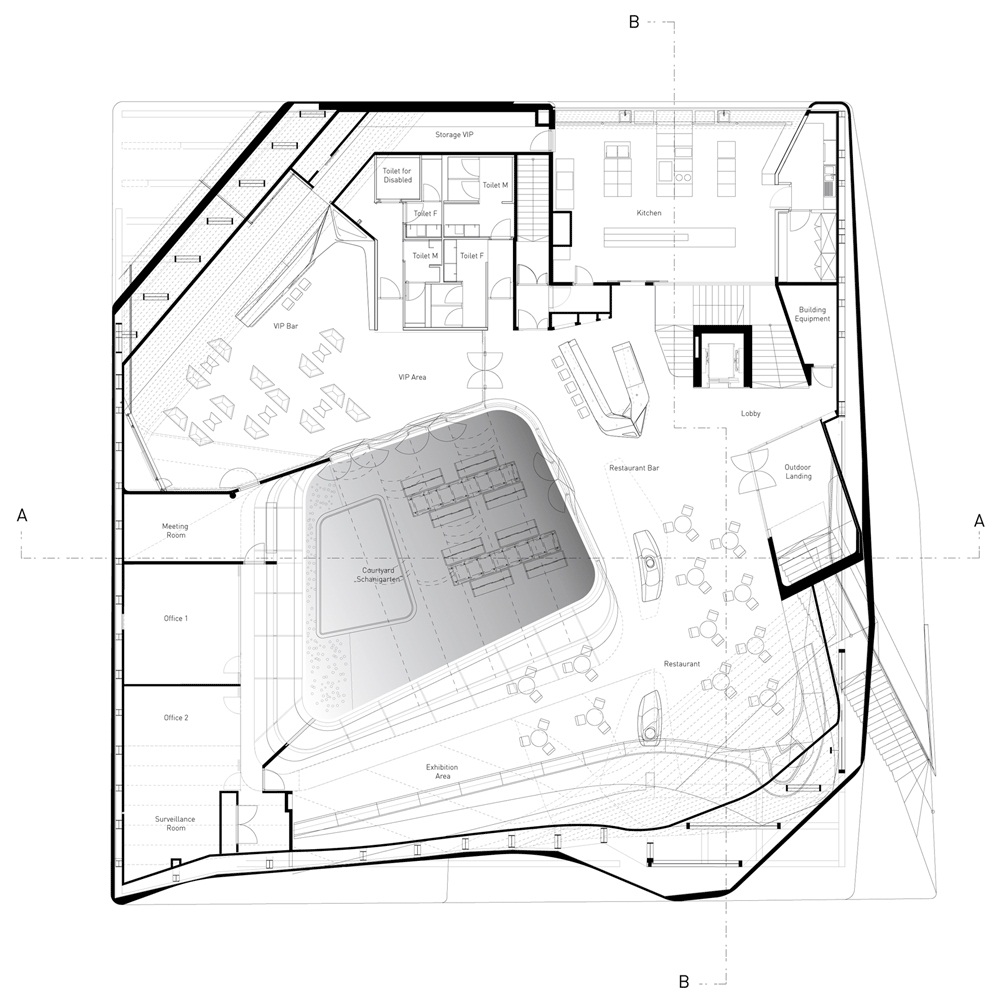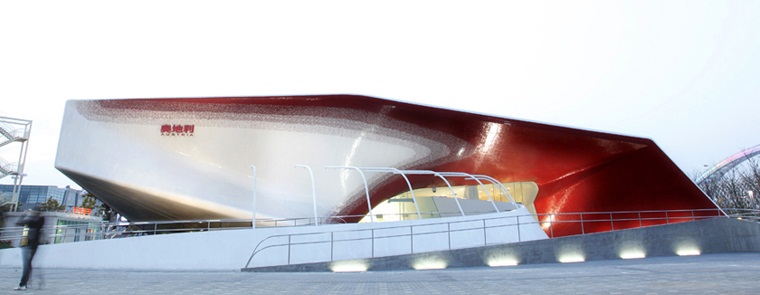Οι SPAN μας εξηγούν τις συνθετικές αρχές του έργου:
Οι χωρικές σχέσεις των επιμέρους ενοτήτων του έργου, υιοθετούν την ισορροπία, τον διαχωρισμό αλλά και την συνύπαρξη μεταξύ της πόλης και της υπαίθρου. Η αφαιρετική εσωτερική “τοπογραφία” (landscape) λειτουργεί ώς ένας χώρος που μπορεί να βιώσει κανείς μέσα απο την αίσθηση της ρυθμικής κίνησης που βιώνει, καθώς κινείται απο τον αίθριο στον εσωτερικό χωρο. Το κεντρικό “δωμάτιο” ξεδιπλώνεται απο μέσα προς τα έξω. Οι καμπύλες χαράξεις δημιουργούν μια συνέχεια που παραλαμβάνει και κατευθύνει την ροή των επισκεπτών, απο την είσοδο, στο εσωτερικό και στην έξοδο του κτηρίου. Οι συνεχείς και χωρίς ραφές (seamless) εσωτερικές επιφάνειες, επιτρέπουν στο βλέμμα να πλανηθεί απρόσκοπτα απο την μία video προβολή στην επόμενη. Πανοραμικά video και εικόνες προβάλλονται στους τοίχους, δάπεδα και οροφές, “πλημμυρίζοντας” το εσωτερικό.
Αυτό που μοιάζει “οργανικό”, είναι στην πραγματικότητα αποτέλεσμα μαθηματικών δομών, υπολογισμένων στην ελάχιστη λεπτομέρεια. Αν και παράδοξο, τα μαθηματικά θεωρούνται απο κάποιους ως μια παγκόσμια γλώσσα, ικανή να εξηγήσει τα πάντα: απο την δομή ενός μουσικού έργου μέχρι την δομή ενός όστρακου. Με αυτή την λογική, γεωμετρικά και μαθηματικά συστήματα ενσωματώθηκαν στην συνθετική διαδικασία για τον σχεδιασμό ενός λειτουργικού κελύφους.
Δέκα εκατομμύρια πλακίδια απο πορσελάνη καλύπτουν χωρίς αρμούς το σύνθετο κέλυφος του κτηρίου που επιλύθηκε κατασκευαστικά με εξήντα εκατομμύρια επιμέρους συνδέσεις. Η επιλογή των πλακιδίων για την κάλυψη του περίπτερου αποτελεί ταυτόχρονα αναφορά στην εξαξωγή Κινεζικής πορσελάνης στην Ευρώπη.
Όλη η εσωτερική επίπλωση ακολουθεί την ίδια σχεδιαστική λογική με το υπόλοιπο έργο, δημιουργώντας ένα ενιαίο σύνολο απο αρχιτεκτονικές χειρονομίες που ενισχύει η μία την άλλη. Τα αρχιτεκτονικά στοιχεία-έπιπλα κατασκευάστηκαν με την χρήση αυτοματοποιημένων μηχανημάτων (CNC, Computer Numeric Control) απο πολυουρεθάνη υψηλής πυκνότητας, η οποία καλύφθηκε απο συνθετική ρητίνη. (Η τεχνολογία CNC χρησιμοποιήθηκε για πρώτη φορά στην αεροναυπηγική, επιτρέποντας την κατασκευή με ακρίβεια ψηφιακά σχεδιασμένων αντικειμένων με σύνθετη καμπυλότητα.)
EN
The spatial relationships of the pavilion playfully adopt the balance, division and symbiosis between the town and the countryside. Abstract landscapes as sensual experiential spaces generate a rhythmical movement from the natural space to the cultural acoustically condensed urban space. The central room unfolds from the inside outwards. The curvilinear sequence of interior spaces supports the flow of visitors from the entrance area through the exhibition grounds to the exit. Thanks to the seamless transitions the visuals can unfold freely and unhindered in the space. Panoramas and imagery are projected onto the walls, floor and ceiling to fill the interior.
What looks organic is the result of mathematical structures calculated in minute detail. Only apparently a paradox, the mathematics are understood as the universal language, capable of describing everything, from the structure of a piece of music to the geometry of an oyster shell Geometric and mathematical systems present in natural phenomena are embedded directly into the design to increase the efficiency of the form.
Enrobed in ten million porcelain tiles, the pavilion takes the form of a seamlessly shimmering building, spectacularly reconciling elegant with futuristic elements. The cladding of the complex curved surface encasing the entire outdoor surface and the roof was made possible by the selection of very small hexagonal modules. The result is what appears to be a smooth, seamless surface, regardless of its opposite nature: 60 million joints result in a regular distribution of the tension in the façade. The design also alludes to the tradition of Chinese porcelain exports to Europe.
In the designing and planning phases, SPAN & Zeytinoglu predominantly work with digital models, a method allowing them to integrate e.g. achievements of topology, the exploration of complex curved geometries. The Austrian pavilion directly reflects this practice. Its organic, curvilinear forms and the continuous flow between spaces base on natural geometric systems.
Based on the design methodology for the Pavillion, SPAN & Zeytinoglu also developed the entire interior design including the restaurant, the shop and the VIP area in addition to the exhibition space and the office area. As part of the interior fittings, the team designed the restaurant and the VIP bar, the shop desk, the info desk, the modular sitting lounge in the VIP area and the reception desk in the VIP lobby.
Although the objects have a value of their own, their integration into the architecture is essential: Spaces and objects form a symbiosis and enhance each other. The design objects are made from CNC-milled polyurethane and coated with synthetic resin. CNC (Computer Numerical Control) is a technology originally developed for the aviation industry, enabling the precise construction of digitally generated, complexly curved objects.
 ΚΑΤΟΨΗ ΟΡΟΦΟΥ
ΚΑΤΟΨΗ ΟΡΟΦΟΥ ΚΑΤΟΨΗ ΙΣΟΓΕΙΟΥ
ΚΑΤΟΨΗ ΙΣΟΓΕΙΟΥ ΛΕΠΤΟΜΕΡΕΙΑ ΕΠΙΠΛΟΥ ΚΑΤΑΣΚΕΥΑΣΜΕΝΟ ΜΕ CAM
ΛΕΠΤΟΜΕΡΕΙΑ ΕΠΙΠΛΟΥ ΚΑΤΑΣΚΕΥΑΣΜΕΝΟ ΜΕ CAM (C) SPAN
(C) SPAN (C) SPAN
(C) SPAN ΑΜΦΙΘΕΑΤΡΟ (C) SPAN
ΑΜΦΙΘΕΑΤΡΟ (C) SPAN ΑΝΑΨΥΚΤΗΡΙΟ (C) SPAN
ΑΝΑΨΥΚΤΗΡΙΟ (C) SPAN ΑΠΟΨΗ ΤΗΣ ΕΙΣΟΔΟΥ (C) SPAN
ΑΠΟΨΗ ΤΗΣ ΕΙΣΟΔΟΥ (C) SPAN (C) SPAN
(C) SPAN (C) SPAN
(C) SPAN
 ΚΑΤΟΨΗ ΟΡΟΦΟΥ
ΚΑΤΟΨΗ ΟΡΟΦΟΥ ΚΑΤΟΨΗ ΙΣΟΓΕΙΟΥ
ΚΑΤΟΨΗ ΙΣΟΓΕΙΟΥ ΛΕΠΤΟΜΕΡΕΙΑ ΕΠΙΠΛΟΥ ΚΑΤΑΣΚΕΥΑΣΜΕΝΟ ΜΕ CAM
ΛΕΠΤΟΜΕΡΕΙΑ ΕΠΙΠΛΟΥ ΚΑΤΑΣΚΕΥΑΣΜΕΝΟ ΜΕ CAM (C) SPAN
(C) SPAN (C) SPAN
(C) SPAN ΑΜΦΙΘΕΑΤΡΟ (C) SPAN
ΑΜΦΙΘΕΑΤΡΟ (C) SPAN ΑΝΑΨΥΚΤΗΡΙΟ (C) SPAN
ΑΝΑΨΥΚΤΗΡΙΟ (C) SPAN ΑΠΟΨΗ ΤΗΣ ΕΙΣΟΔΟΥ (C) SPAN
ΑΠΟΨΗ ΤΗΣ ΕΙΣΟΔΟΥ (C) SPAN (C) SPAN
(C) SPAN (C) SPAN
(C) SPAN